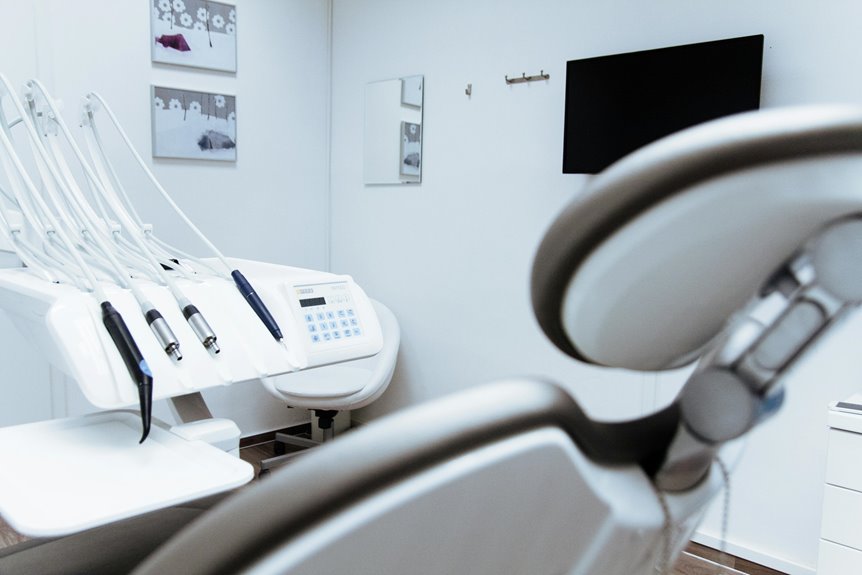Did you know that dental practice owners can save thousands annually through effective tax strategies? By understanding and implementing tax-advantaged accounts, maximizing deductions, and exploring depreciation options, you can greatly reduce your tax burden. However, maneuvering through these strategies can be complex, and missing out on key opportunities might cost you. What if there are lesser-known techniques that could further enhance your savings? Let us explore some of these effective approaches that could change the way you manage your practice's finances.
Key Takeaways
- Maximize contributions to tax-advantaged accounts like HSAs and 401(k)s for tax deductions and long-term growth benefits.
- Utilize deductible business expenses, including home office costs and continuing education, to reduce taxable income effectively.
- Implement depreciation strategies, such as Section 179 and bonus depreciation, for significant write-offs on equipment purchases in the service year.
- Consider charitable contributions, especially appreciated assets, to optimize tax deductions and minimize capital gains tax liabilities.
- Employ family members in the practice to take advantage of income splitting, allowing wage deductions and potentially lowering overall tax liabilities.
Tax-Advantaged Accounts

When you're looking to maximize your tax savings as a dental practice owner, tax-advantaged accounts can be a game changer.
Health Savings Accounts (HSAs) let you contribute pre-tax funds for qualified medical expenses, offering triple tax benefits: tax-deductible contributions, tax-free growth, and tax-free withdrawals.
For 2023, you can contribute up to $3,850 for individuals or $7,750 for families, with an extra $1,000 catch-up for those 55 and older.
Retirement accounts like 401(k)s help reduce your taxable income, allowing contributions up to $22,500, plus a $7,500 catch-up option for those over 50.
Don't forget about Flexible Spending Accounts (FSAs) for tax-free funds, or traditional and Roth IRAs for smart retirement savings.
These strategies can greatly enhance your financial health.
Business Deductions
Maximizing your tax savings as a dental practice owner goes beyond tax-advantaged accounts; business deductions play an essential role in reducing your taxable income.
You can deduct vital expenses like office supplies, uniforms, and malpractice insurance. If you have a dedicated space for your practice at home, don't forget about home office expenses, which can also yield significant savings.
Tangible property deductions let you write off costs for the equipment and furnishings you use daily. Plus, continuing education expenses for courses and seminars that enhance your skills are fully deductible.
Depreciation Strategies

Understanding depreciation strategies is essential for dental practice owners who want to enhance their tax savings. By leveraging Section 179, you can deduct up to $1,160,000 in qualifying equipment purchases in the year they're placed in service.
Additionally, bonus depreciation for 2023 allows you to write off 80% of the cost of qualifying new and used property in the initial year, speeding up your tax benefits.
You can choose between straight-line depreciation, which spreads costs evenly, or accelerated methods, which yield larger deductions early on.
Consider cost segregation studies to identify components of your property, allowing for shorter depreciation periods.
Regular reviews of asset values and depreciation schedules can further optimize your tax strategy, ensuring compliance and maximizing tax savings.
Charitable Contributions
Charitable contributions can be a potent tool for dental practice owners looking to reduce their tax liability while supporting causes they care about. By donating to qualified charities, you can claim tax deductions up to 60% of your adjusted gross income (AGI).
Consider donating appreciated assets, like stocks, to avoid capital gains tax while still receiving the full market value deduction. Utilizing Donor-Advised Funds allows you to enjoy an upfront deduction and flexibility in distributing funds over time.
Timing charitable contributions strategically, especially in high-income years, maximizes your tax benefits. Also, making donations directly from your Required Minimum Distributions (RMDs) can lower your taxable income without affecting your AGI, resulting in additional tax savings.
Income Splitting

Income splitting presents another effective strategy for dental practice owners aiming to lower their tax burden while involving family in the business.
By employing family members in legitimate roles, you can deduct their wages as business expenses, reducing your taxable income. Utilizing income partnerships allows you to distribute profits among family members, optimizing tax liabilities.
Establishing trusts can also facilitate these strategies, enabling you to allocate income to beneficiaries in lower tax brackets while maintaining control over assets.
However, it's essential to maintain proper documentation of family roles and contributions to comply with IRS regulations. This guarantees your income-splitting strategies are legitimate and defendable, maximizing your potential tax savings while keeping your family engaged in your practice.
Frequently Asked Questions
Can I Write off Dental Work on My Business Taxes?
You can write off certain dental expenses as business expenses if they meet IRS guidelines. Tax deductions for qualified deductions include specific practice expenses, so keep meticulous expense tracking for personal and professional costs for effective tax planning.
How Can I Increase My Dental Office Revenue?
To boost your dental office revenue, weave together patient retention and marketing techniques. Diversify services, sharpen pricing strategies, invest in technology, engage the community, nurture referral programs, and train staff to enhance your online presence.
What Are Four Strategies to Reduce Income Tax Liability That You Could Take Advantage of in the Future?
To reduce your income tax liability, consider tax deferral options, maximize retirement plan contributions, leverage business expense deductions, and utilize health savings accounts. Also, explore depreciation benefits, tax credits, and charitable giving benefits for additional savings.
What Is the Tax Strategy for High Income Earners?
For high-income earners, effective tax planning tips include maximizing retirement account benefits, exploring tax credits, tracking business expenses, utilizing asset depreciation strategies, and consulting a financial advisor for tailored advice and tax-saving software.
Conclusion
Incorporating these effective tax strategies can considerably boost your dental practice's financial health. Did you know that dental practice owners can save an average of 20-30% on taxes by utilizing these techniques? By leveraging tax-advantaged accounts, maximizing deductions, and exploring depreciation options, you can keep more of your hard-earned money. Don't leave money on the table—start implementing these strategies today and watch your savings grow. Your financial future deserves the best planning you can provide.


